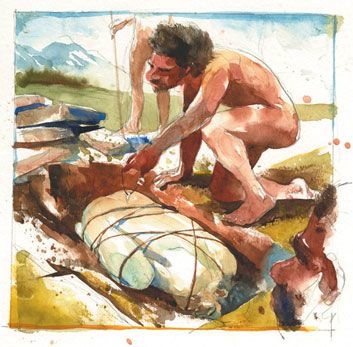Anthropology
Related: About this forumRethinking Neanderthals
Neanderthals were not only “human” but also, it turns out, more “modern” than scientists previously allowed. “In the minds of the European anthropologists who first studied them, Neanderthals were the embodiment of primitive humans, subhumans if you will,” says Fred H. Smith, a physical anthropologist at Loyola University in Chicago who has been studying Neanderthal DNA. “They were believed to be scavengers who made primitive tools and were incapable of language or symbolic thought.” Now, he says, researchers believe that Neanderthals “were highly intelligent, able to adapt to a wide variety of ecologicalzones, and capable of developing highly functional tools to help them do so. They were quite accomplished.”
Contrary to the view that Neanderthals were evolutionary failures—they died out about 28,000 years ago—they actually had quite a run. “If you take success to mean the ability to survive in hostile, changing environments, then Neanderthals were a great success,” says archaeologist John Shea of the State University of New York at Stony Brook. “They lived 250,000 years or more in the harshest climates experienced by primates, not just humans.” In contrast, we modern humans have only been around for 100,000 years or so and moved into colder, temperate regions only in the past 40,000 years.
Neanderthals appear to have descended from an earlier human species, Homo erectus, between 500,000 to 300,000 years ago. Neanderthals ... were as big-brained as the anatomically modern humans, Homo sapiens, that later colonized Europe. Neanderthals inhabited a vast area roughly from present-day England east to Uzbekistan and south nearly to the Red Sea. Paleoanthropologists have no idea how many Neanderthals existed (crude estimates are in the many thousands), but archaeologists have found more fossils from Neanderthals than from any extinct human species.
https://www.smithsonianmag.com/science-nature/rethinking-neanderthals-83341003/
Indicating that Neanderthals buried their dead, a stone-lined pit in southwest France held the 70,000-year-old remains of a man wrapped in bearskin.
The illustration is based on a diorama at Smithsonian's National Museum of Natural History.
(Stan Fellows)

alwaysinasnit
(5,247 posts)central scrutinizer
(12,440 posts)alwaysinasnit
(5,247 posts)List left
(627 posts)NCjack
(10,297 posts)parties concerned: DEMs, Neanderthals, and Repukes.
Karadeniz
(23,388 posts)d_r
(6,907 posts)"Kindred" by Wragg Sykes.